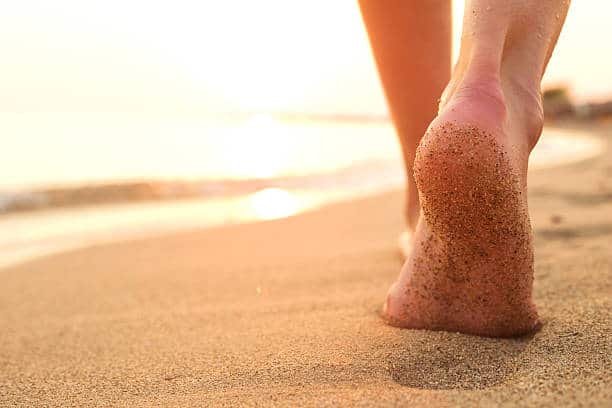Summer is here! Sun, fun and sand! But wait – why does the bottom of your foot hurt so much? It could be Plantar Fasciitis – inflammation and stress of the ligament that connects your toes and heel bone. Plantar Fasciitis is a common cause of heel pain, but is Plantar Fasciitis more common in the summer? Let’s delve into the causes, symptoms, and treatment of this condition in relation to warm weather.
Causes of Plantar Fasciitis in the Summertime
There are two main ways summertime weather can impact Plantar Fasciitis symptoms:
- Increased Activity – During the summer, most people tend to be more active, engaging in exercises, walks, and runs. All this repetitive activity puts stress on your heels and weakens the tendons, leading to inflammation and the onset of Plantar Fasciitis symptoms.
- Choices of Footwear– In the summer, people often opt for flip-flops, sandals, or even going barefoot, trading in their regular shoes and boots. Unfortunately, these warm weather shoes provide much less support, increasing the strain on your muscles and tendons.
Other Contributing Factors of Plantar Fasciitis
Apart from warm weather, there are other factors that can irritate or cause stress on the plantar fascia resulting in swelling, inflammation and even small tears in the fascias. Other factors include:
- Running or participating in activities involving jumping
- Being overweight
- Jobs or hobbies that require a lot of standing
- Being over the age of 40
- Swelling and pain from arthritis in the toes
- Wearing high heels
Symptoms of Plantar Fasciitis
- Pain in the bottom of the foot, near the heel or in the arch
- Sharp, burning pain when getting out of bed in the morning or after sitting for a while
- Pain that improves with walking
- Increased pain after exercise
If left untreated, Plantar Fasciitis can cause long-term discomfort and pain.
Treatment Options for Plantar Fasciitis
- Daily stretching of the calf, Achilles tendon and plantar fascia
- Applying ice or using a frozen bottle of water to roll under your foot
- Taking anti-inflammatory medications like ibuprofen, naproxen, or aspirin. Cortisone injections may be used for severe or long-term symptoms.
- Using compression sleeves, such as the FS6 Compression Foot Sleeve, to provide pain relief and support.
- Wearing braces and splints, such as the 3pp Arch Lift, during the day to reduce stress on the arch and heel.

Remember, patience is key when dealing with Plantar Fasciitis. Most people recover from it, but it can take between six to ten months, just in time for the next summer season.
Like what you’ve read? Click here to subscribe to the blog!
Learn More About Plantar Fasciitis Products
Click on the image below

View Video
How To Wear the Orthosleeve FS6 Compression Foot Sleeve
Our blogs are educational in nature and are not intended as a substitute for medical advice. Because your condition is unique to you, it is recommended that you consult with your health care provider before attempting any medical or therapeutic treatments. We are always happy to answer questions about products mentioned in our blogs, however, we cannot provide a diagnosis or medical advice.
About the Author:
Ginny Wolfe has been a dedicated team member at Oh My Arthritis (OMA) for over a decade. Her knowledge and expertise of OMA’s orthopedic products play a vital role in providing valuable health and wellness information. This information effectively showcases the benefits and features of their products, empowering customers to make informed choices.
OMA is celebrated for its dedication to improving the lives of those living with arthritis, injuries, and various health conditions. With a mission to deliver innovative and effective solutions, OMA has earned trust by offering products that alleviate pain and enhance joint mobility. Known for its premium splints, braces, and supports, OMA empowers individuals to maintain an active lifestyle while finding relief.

